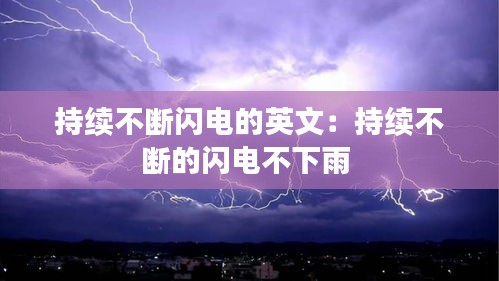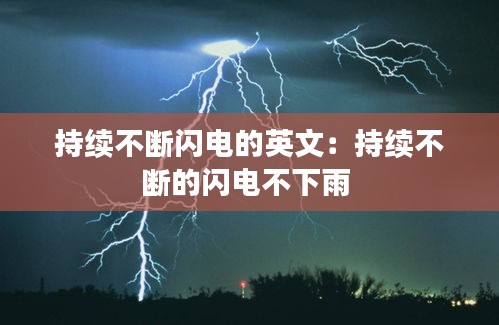Introduction to Continuous Lightning
Lightning, one of the most spectacular and mysterious natural phenomena, is a subject of fascination for scientists and enthusiasts alike. While most lightning occurrences are brief and isolated, there are instances where lightning appears to strike continuously. This article delves into the intriguing world of continuous lightning, exploring its causes, characteristics, and the scientific theories that attempt to explain this extraordinary phenomenon.
What is Continuous Lightning?
Continuous lightning, also known as persistent lightning, is a rare and fascinating event where lightning strikes occur one after another without any significant pause. Unlike the typical lightning strikes that last for a few milliseconds, continuous lightning can persist for several seconds, minutes, or even hours. This prolonged duration makes it a rare and remarkable sight in the natural world.
Causes of Continuous Lightning
The exact causes of continuous lightning are still not fully understood, but scientists have proposed several theories to explain this phenomenon. One of the leading theories is the presence of a strong updraft in the atmosphere, which creates a conducive environment for the formation and persistence of lightning. When moist, warm air rises rapidly, it can create a towering cumulonimbus cloud, which is a prime candidate for lightning formation. If the updraft is strong enough and continues for an extended period, it can lead to continuous lightning strikes.
Another theory suggests that the presence of a large, dense hail shower within the cloud can contribute to continuous lightning. The falling hail can create a charge separation within the cloud, leading to multiple lightning strikes. If the hail shower persists, so does the lightning activity.
Characteristics of Continuous Lightning
Continuous lightning has several distinct characteristics that differentiate it from typical lightning strikes. Firstly, the color of continuous lightning is often different. While typical lightning appears white or blue, continuous lightning can appear greenish or yellowish, giving it a unique and eerie appearance. This color change is attributed to the longer duration of the lightning strike, which allows for more spectral emission.
Additionally, continuous lightning is often accompanied by a persistent crackling or buzzing sound, which can be heard for several seconds or minutes. This sound is caused by the rapid expansion and contraction of the air around the lightning channel as the lightning discharge occurs.
Observing Continuous Lightning
Observing continuous lightning is a challenging task due to its rarity and the need for favorable weather conditions. However, when it does occur, it can be a mesmerizing sight. Photographers and storm chasers often document these events, capturing the beauty and intensity of continuous lightning in images and videos.
Continuous lightning has been observed in various parts of the world, including the United States, Australia, and South America. The most famous instance of continuous lightning was recorded in 2007 in Brazil, where lightning struck for 45 consecutive minutes.
Scientific Theories and Research
Despite the advancements in meteorology and lightning research, the exact mechanisms behind continuous lightning are still a subject of study. Scientists use various tools and techniques to study lightning, including lightning detection networks, radar systems, and satellite observations. These tools help in understanding the physical processes that lead to continuous lightning.
One of the key challenges in studying continuous lightning is the difficulty in collecting data during these events. However, advancements in technology have allowed for better data collection and analysis, providing valuable insights into the nature of continuous lightning.
Conclusion
Continuous lightning remains one of the most intriguing and enigmatic natural phenomena. While the exact causes and mechanisms are not yet fully understood, the research and observations continue to shed light on this extraordinary event. As technology advances and our understanding of the atmosphere deepens, we may eventually uncover the secrets behind continuous lightning, revealing even more about the complex and fascinating world of weather and storms.
转载请注明来自互诺实验设备(衡水)有限公司,本文标题:《持续不断闪电的英文:持续不断的闪电不下雨 》















 冀ICP备2024085275号-1
冀ICP备2024085275号-1
还没有评论,来说两句吧...